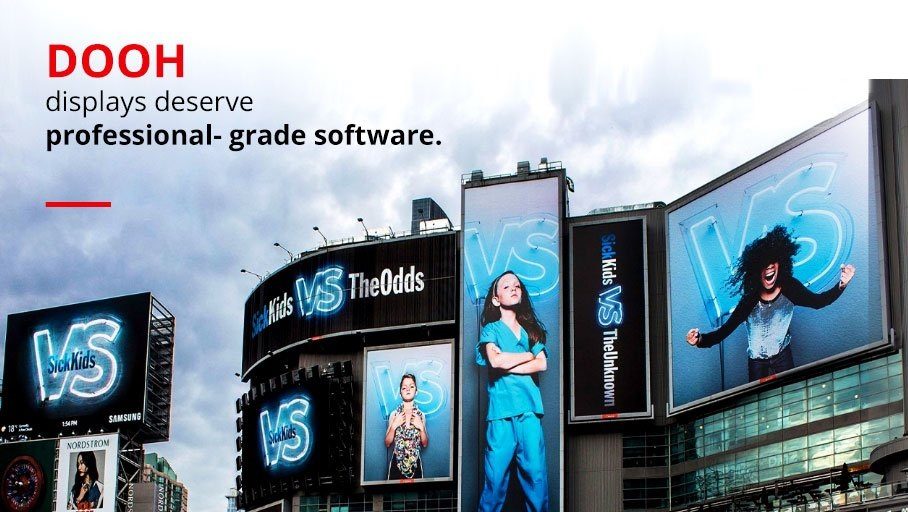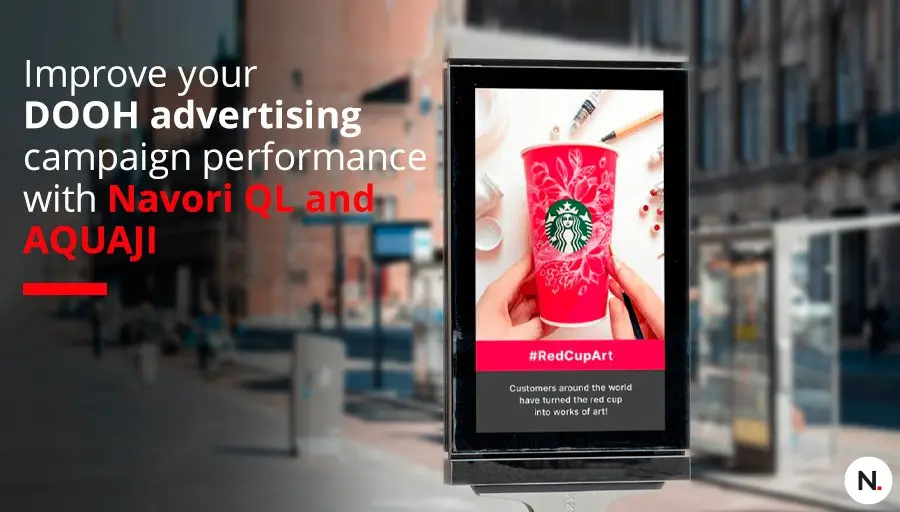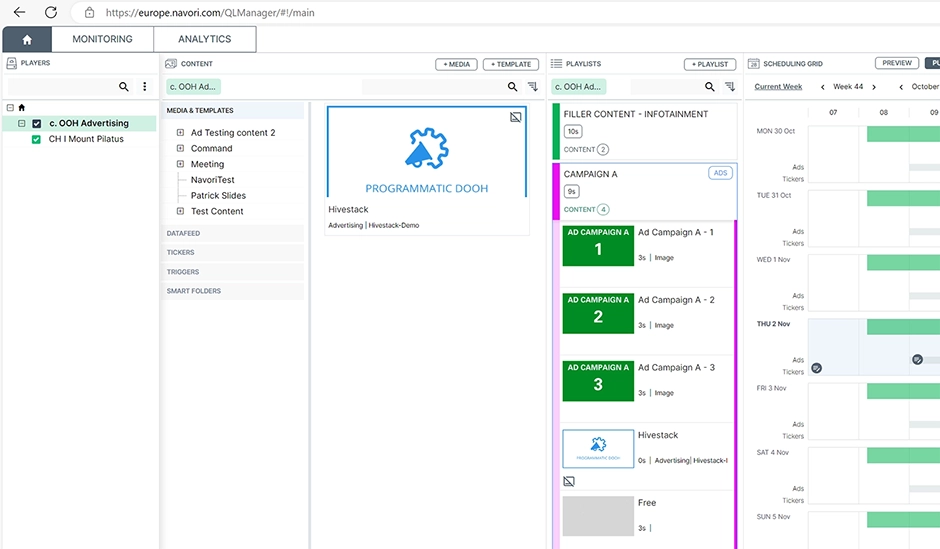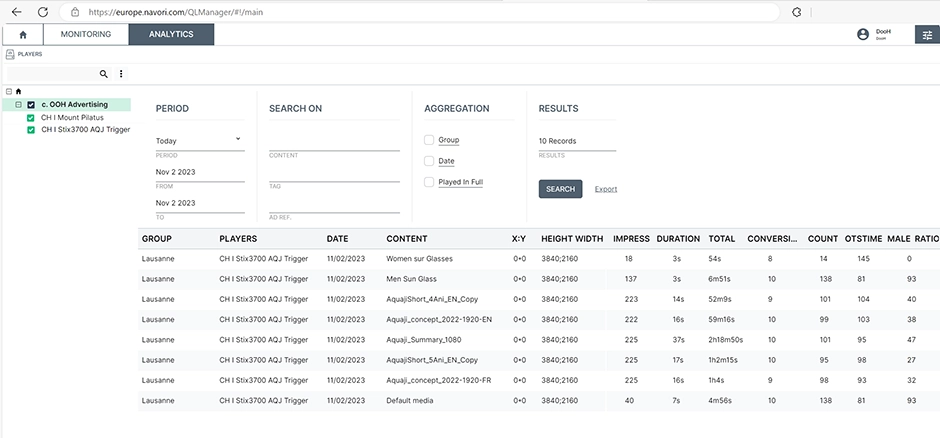DooH Advertising
DooH Advertising with Navori’s Outdoor Digital Signage Software

Understanding the Needs and Challenges of DooH Advertising
In the fast-moving world of DOOH advertising, where ads are shown on various screens outdoors, operators often struggle with managing complicated media plans. Success in this field depends on using software that can handle detailed scheduling, automatic ad placements, and measuring the audience in real-time. Navori stands out as a solution tailored to these needs, offering comprehensive tools for creating, distributing, and playing outdoor digital advertising content.
However, challenges in programmatic DOOH advertising include quickly changing ad content, the need to include up-to-date data, and making sure ads perform well on outdoor digital displays. Navori tackles these issues effectively, giving operators a dependable and efficient way to manage and sell their programmatic DOOH campaigns. By leveraging Navori’s capabilities, businesses can optimize their DOOH ads to engage audiences and maximize impact.

Why Use Outdoor Digital Signage for DooH Advertising?
Impactful Content Management
With Navori’s content management system, you can easily schedule, update, and control ads on different outdoor digital displays. This is important for keeping ads visible and impactful in outdoor spaces, ensuring your DOOH ads always capture the audience’s attention. Whether it’s using touch screens for product browsing or offering mobile interactions like QR code scans for discounts, adding interactivity to an outdoor digital display boosts audience engagement and retention. For example, in high-traffic areas like transit stations or shopping malls, users can interact with games, surveys, or even virtual try-ons, making DOOH ads more dynamic and memorable. By incorporating interactive elements into outdoor digital signage, advertisers can elevate the overall experience and create more personalized, attention-grabbing campaigns.
Managing Multiple Locations with Ease
Managing DOOH advertising for an outdoor digital display can be complex, especially when coordinating campaigns across multiple locations in different cities or regions. Navori’s centralized Content Management System (CMS) simplifies this process by allowing advertisers to control content across thousands of outdoor digital displays from a single dashboard. This eliminates the need for local teams to update content manually, ensuring that all signage is synchronized and consistent with the brand’s messaging. This saves time, reduces operational costs, and ensures that no location is out of sync.
Addressing Audience Targeting Challenges
DOOH advertisers often struggle with delivering relevant ads to specific audiences at the right time. Navori addresses this challenge with its AQUAJI marketing analytics and real-time data integration. The software gathers and analyzes viewer demographics, such as age and gender, without breaching privacy, to tailor content based on who is in front of the screen. For example, if the system detects a younger demographic, the screen might display ads for fashion or entertainment, while older viewers might see healthcare or financial service promotions. Advertisers can deliver targeted, personalized DOOH ads in real-time, making campaigns more effective. By integrating with external data sources, Navori helps enhance the targeting precision of programmatic DOOH advertising, ensuring the right message reaches the right audience.
Reducing Operational Complexity
For advertisers managing large, dynamic campaigns, the constant need to update and adjust content can become overwhelming. Navori’s dynamic content scheduling allows advertisers to automate much of the content management process. Ads can be scheduled to change based on specific time slots, events, or real-time factors like weather conditions or foot traffic patterns. This reduces the manual workload and ensures that the content is always relevant for outdoor digital display advertising without constant intervention. It also makes DOOH programmatic campaigns more agile, letting advertisers quickly adapt to changing conditions without interrupting the campaign flow.
Scalable Solutions for Every Campaign
Our software adapts to any size of digital out-of-home (DOOH) advertising campaign. It works great whether you’re using one screen or thousands, ensuring smooth operation on all outdoor digital signage and devices.
Reliability in Outdoor Environments
Count on Navori QL’s robust platform to deliver unwavering performance, which is essential for outdoor environments where continuous operation is crucial. Eliminate the possibility of blank screens and never miss a conversion opportunity again in your outdoor digital advertising efforts.
Overcoming Weather-Related Interruptions
Outdoor digital advertising presents unique challenges, such as exposure to extreme weather conditions. These factors can disrupt outdoor digital display campaigns, leading to downtime and missed advertising opportunities. Navori’s QL software is designed with robust, weather-resistant performance in mind. By offering continuous operation in extreme environments—whether it’s rain, heat, or freezing temperatures—Navori ensures that advertisers don’t face interruptions due to weather-related issues. This reliability prevents costly outages and ensures that DOOH ads are always visible and engaging, regardless of the environment.
Smart Analytics for Campaign Optimization
Navori software provides detailed analytics and reports. These give you important information about how people are responding to your ads and how well your campaign is doing. This helps you make smart changes to improve your campaign and show that your programmatic DOOH ads are effective.
Real-Time Data Integration
Navori QL integrates live data feeds, viewer demographics, and interactive elements, making outdoor advertisements more dynamic and engaging. This integration is key to creating programmatic DOOH advertising that captures audiences’ attention and delivers relevant messages.
Streamlining Programmatic Ad Buying
One of the challenges in DOOH advertising is efficiently managing the buying and placement of ads across multiple platforms and networks. Navori simplifies this process by supporting DOOH programmatic advertising, which allows for automated buying, selling, and placement of ads. The integration with third-party demand-side platforms (DSPs) and supply-side platforms (SSPs) streamlines the process of inserting ads into your campaign. This helps fill ad slots more efficiently, saving time and simplifying the management of multiple advertising networks while boosting the performance of outdoor digital advertising campaigns. Advertisers can use programmatic DOOH technology to reach their audience more effectively and keep operations running smoothly.
Compliance with Local Advertising Regulations
Navigating local advertising regulations can be a headache, especially when deploying outdoor digital signage campaigns across multiple jurisdictions. Navori’s software allows for customized content delivery based on location-specific requirements. Advertisers can configure their outdoor digital displays to comply with local laws by tailoring content to meet these guidelines. Whether it’s adjusting the brightness of screens in residential areas or ensuring content meets local regulations, Navori helps advertisers stay compliant while maintaining an impactful campaign. This ensures that programmatic DOOH campaigns run smoothly while avoiding fines or legal issues.
Real-life Use Cases for DOOH Advertising
Impactful Content Management
With Navori’s content management system, you can easily schedule, update, and control ads on different outdoor digital displays. This is important for keeping ads visible and impactful in outdoor spaces.
Scalable Solutions for Every Campaign
Our software adapts to any size of digital out-of-home (DOOH) advertising campaign. It works great whether you’re using one screen or thousands, ensuring smooth operation on all outdoor digital signage and devices.
Reliability in Outdoor Environments
Count on Navori’s robust platform to deliver unwavering performance, which is essential for outdoor environments where continuous operation is crucial.
Customized Content for Targeted Advertising
Utilize Navori software to customize content based on specific audience segments. The system will then automatically play the most relevant ad, based on the profile of the person standing in front of the screen. This targeted approach ensures a more personalized advertising experience.
Programmatic Advertising with Third-party Integration
Our advertising campaign module can interface with third-party ad booking software (DSP and SSP), simplifying the process of inserting ads into your DOOH advertising playlists. This integration creates a more efficient and automated workflow, ensuring that ad slots are filled optimally for programmatic DOOH.
Data Aggregation from Multiple Sources
Navori software excels in pulling together data from different sources, ensuring that your digital signage reflects the most current and relevant advertising content. This feature is especially useful for dynamic environments where information changes rapidly, like transport hubs or busy commercial areas.
Dynamic Content Updates and Scheduling
Navori empowers operators to make quick and timely updates to advertising content. This includes scheduling ads for specific times of the day or in response to real-time events, ensuring that the content is always relevant for the target audience. Through this capability, your outdoor digital advertising campaigns remain fresh and impactful.
Frequently Asked Questions (FAQs) about DOOH Advertising
What is DOOH advertising?
Many are wondering, what is DOOH advertising? Digital Out-Of-Home advertising refers to the use of outdoor digital signage and outdoor digital displays to deliver advertising content in public spaces. This can include digital billboards and screens in shopping malls, airports, and transit locations. Unlike traditional out-of-home advertising, DOOH allows for dynamic and interactive content that can be updated in real-time.
How does DOOH advertising work?
DOOH advertising uses outdoor digital display to show content, which can be controlled and updated remotely using digital signage software. Advertisers can schedule ads, trigger content based on certain conditions, and gather analytics on viewer engagement. This flexibility allows for targeted and timely messaging through dooh ads
What are the benefits of DOOH advertising?
- Dynamic Content: Easily update and schedule new ads on outdoor digital signage.
- Interactivity: Engage viewers with interactive content.
- Targeted Advertising: Use data to display ads relevant to the audience at specific times and locations.
- Analytics: Collect data on viewer engagement and ad performance to optimize campaigns.
What is programmatic DOOH advertising?
Programmatic DOOH advertising, also known as dooh programmatic, involves using automated technology to buy and sell ad space on digital displays. This allows advertisers to target specific audiences in real-time and optimize their campaigns for better performance. Programmatic DOOH enables more efficient and data-driven ad placements.
What are the future trends in DOOH advertising?
The future of DOOH advertising includes more integration with AI and machine learning to enhance targeting and personalization. Innovations like real-time content generation, improved analytics, and seamless integration with other digital marketing channels are expected to drive the growth of outdoor digital advertising.
Enhance Outdoor Digital Signage with Navori’s Versatile Software
Navori’s features for digital billboards and outdoor digital advertising are versatile and practical, aimed at making this kind of advertising more effective and efficient. They include gathering data, smoothly combining different software, updating content quickly, and providing detailed analysis of who is seeing the DOOH ads. Navori gives operators the tools to create advanced, flexible, and effective programmatic DOOH advertising experiences in outdoor settings.

